Scotland coach Gregor Townsend has named his squad to prepare for the country’s November Tests, with former Canterbury five-eighths Fergus Burke retaining his place in the side.
Scotland, who have never beaten the All Blacks,…
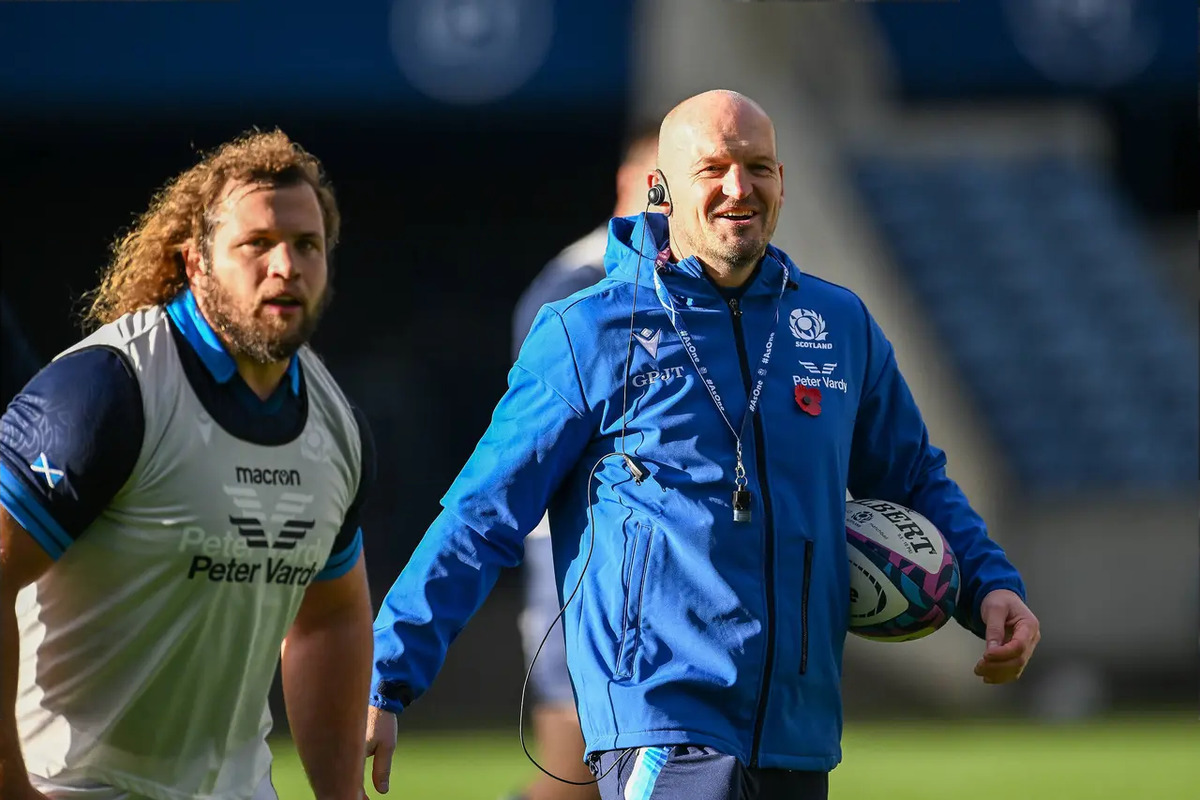
Scotland coach Gregor Townsend has named his squad to prepare for the country’s November Tests, with former Canterbury five-eighths Fergus Burke retaining his place in the side.
Scotland, who have never beaten the All Blacks,…

All products featured on Vogue are independently selected by our editors. However, we may earn affiliate revenue on this article and commission when you buy something.
Few retailers require a keen editor’s eye quite like Zara, where dozens upon…
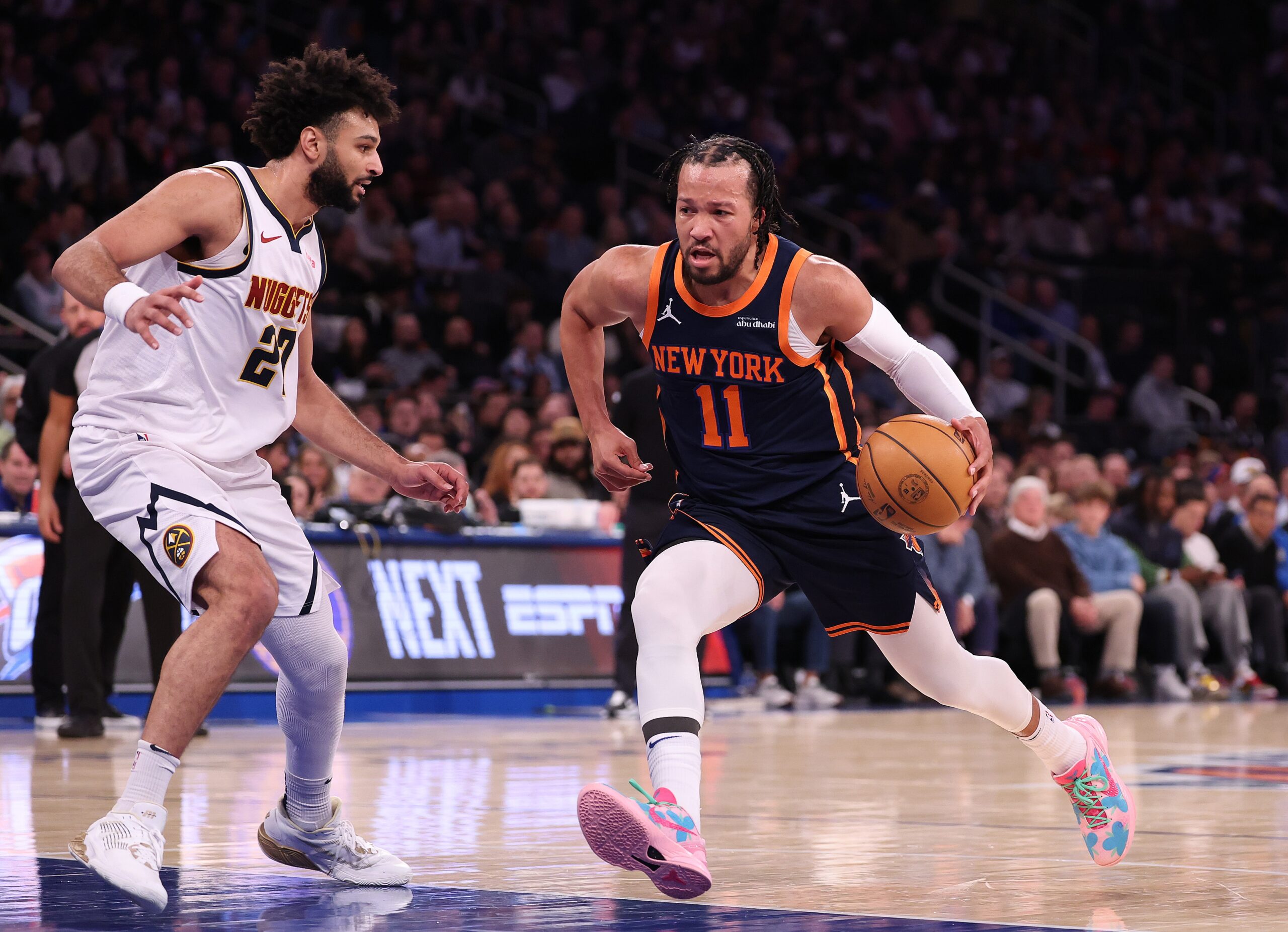
The Cavs and Thunder are among the early favorites to reach the 2026 NBA Finals.
From time to time, NBA.com’s writers will share their takes on the biggest storylines and trends around the league.

Analysis of the respiratory microbiome highlighted the most common bacteria, including Veillonella, Prevotella, Phyllobacterium, and Streptococcus. Moreover, children who recovered without doxycycline (WDT) showed greater bacterial diversity and…

For centuries, the Taftan volcano in southeastern Iran was considered inactive; just another mountain in the desert. But recent evidence shows that something beneath it has started to…
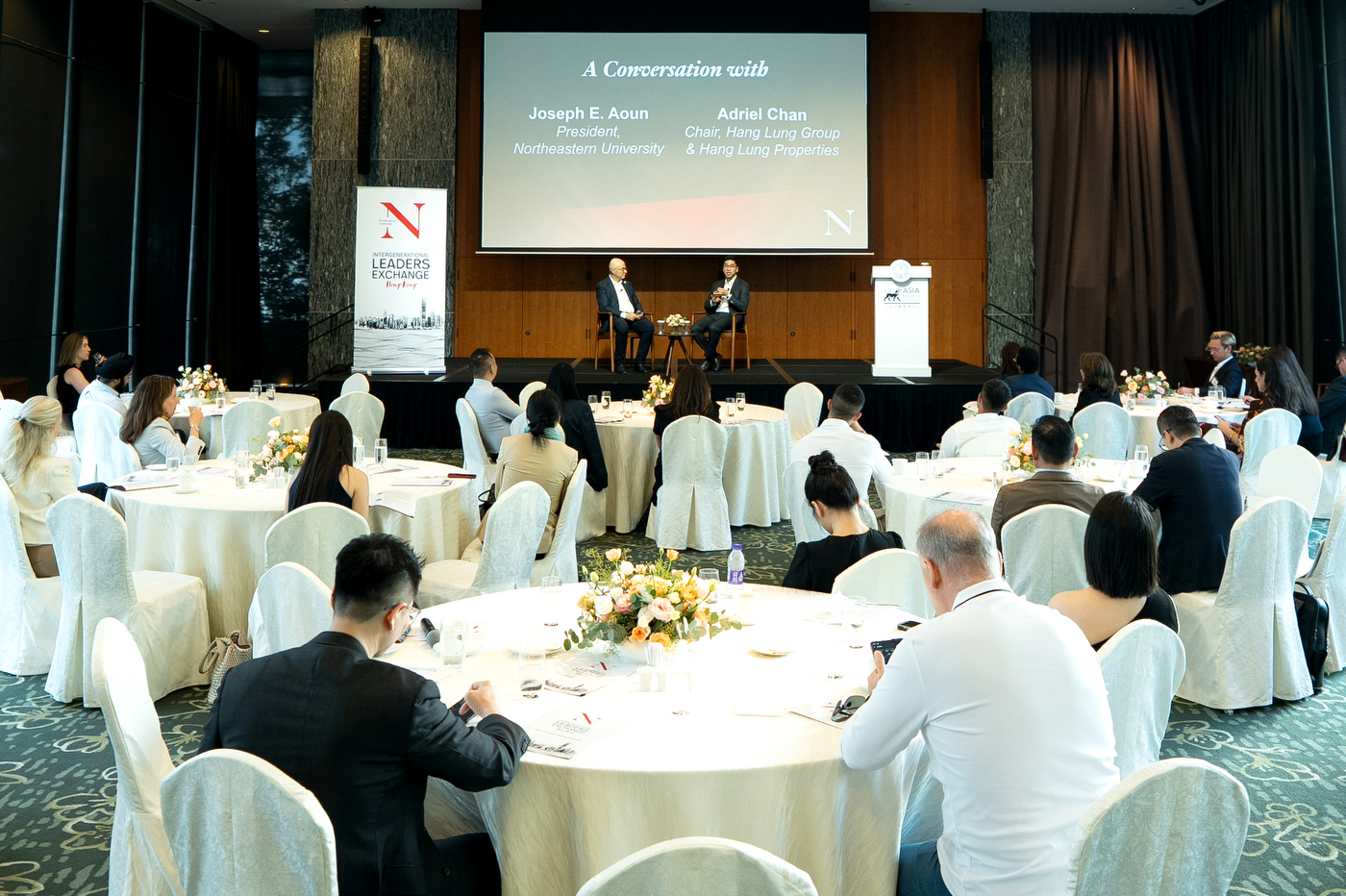
Global leaders gathered in Hong Kong explored how artificial intelligence, human literacy and intergenerational collaboration are transforming education and businesses in a rapidly changing world.
As artificial intelligence reshapes society, the future of education depends on striking a balance between technological fluency and human literacy, Northeastern University President Joseph E. Aoun said.
“What Northeastern is providing is a differentiated education based on precisely this balance between understanding the agency that AI has and the human agency, and allowing you to navigate that for life,” Aoun told a large audience at the university’s third annual Intergenerational Leaders Exchange on Friday and Saturday in Hong Kong.
Artificial intelligence is accelerating this global transformation and universities and businesses — from small, family-owned enterprises to multinational corporations — must embrace agility, openness and sustainable innovation, speakers said.
These themes dominated the summit. Northeastern alumni, parents, partners and prospective students gathered at the Asia Society Center to engage with C-suite leaders, innovators and trailblazers about the AI-driven future of the university, family businesses and global industries.
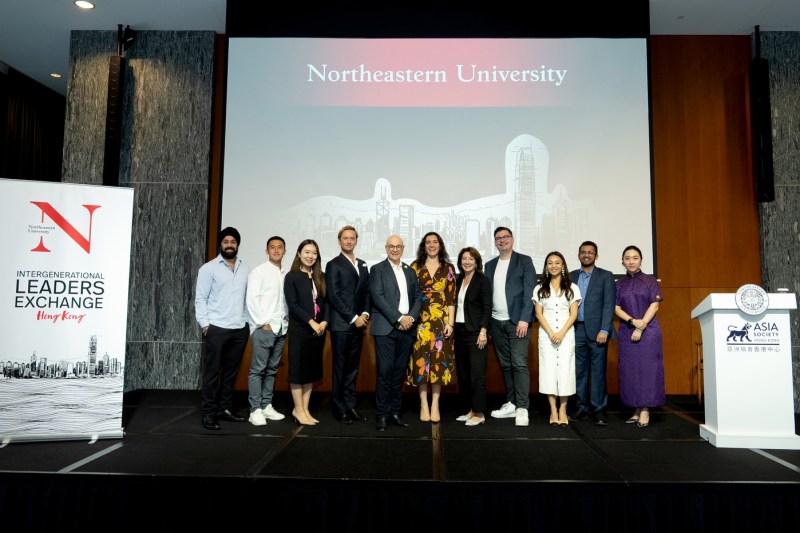



Jean-Pascal Tricoire, chairman of Schneider Electric, a Northeastern University trustee and a parent of students in the class of ’22, ’23 and ’26, emphasized agility over scale.
“The absolute winning factor today is not size, it’s speed,” he said. “You have to be fast, and you can be fast only very close to your customer.”
Participants toured Schneider Electric’s Hong Kong Innovation Hub to see how one of the world’s leading industrial technology companies is advancing smart industries and communities through electrification, automation, the Industrial Internet of Things and resilient infrastructure.
Kathy Sun, a 2018 graduate of Northeastern’s D’Amore-McKim School of Business and founder of Yatir Capital, opened the event by emphasizing the power of intentional intergenerational learning. Choosing to pause and engage in spaces like this, she said, is “in itself an act of leadership.”
“The most valuable learning doesn’t happen in a single classroom or with or within a single generation,” Sun said. “It happens when we intentionally create space for diverse perspectives, experiences and generations to come together.”
Hong Kong, where East meets West, tradition blends with innovation, and family businesses thrive alongside cutting-edge technology companies, was the ideal setting for these conversations, Sun said.



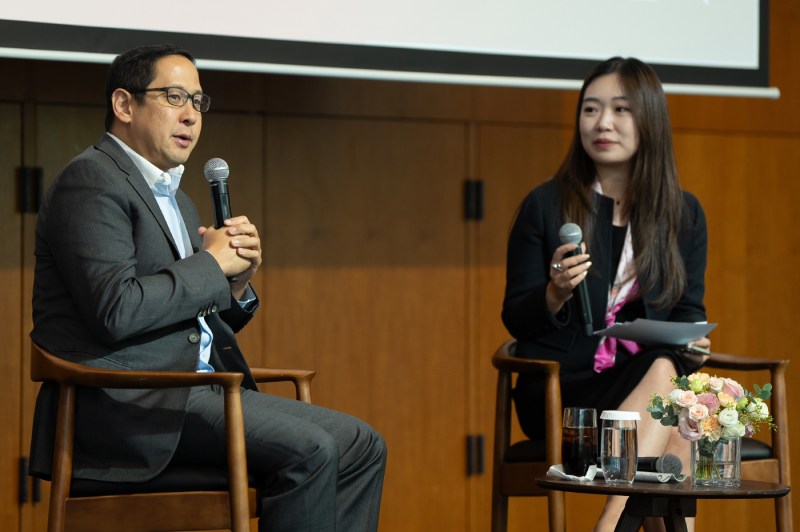
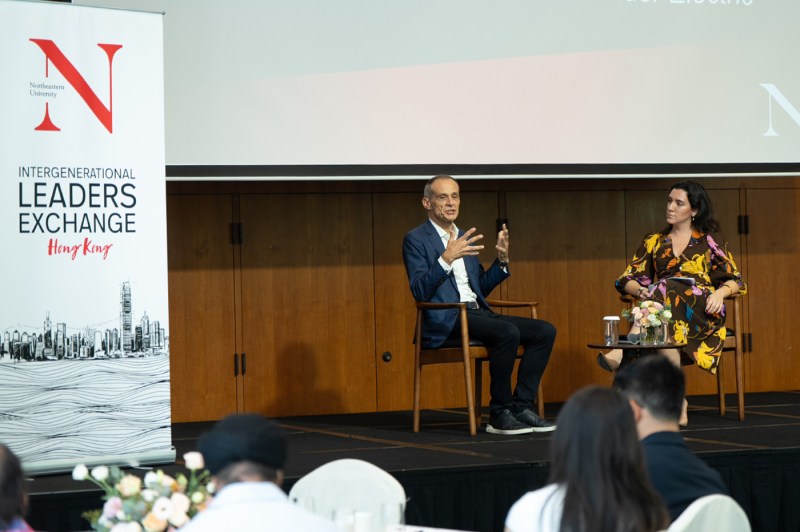
With AI becoming increasingly agentic and making decisions that impact humans, Aoun said, students need to understand what machines can do and what only humans can.
“That’s what we call human literacy,” he said.
He pointed to Northeastern’s 230-plus combined majors, experiential education and lifelong learning opportunities designed to help learners continually reskill and reinvent themselves.
“It is an engagement for life, and we want to be there for you,” he said.
Spencer Fung, executive group chairman of Li & Fung, a Northeastern University trustee and graduate, shared how a 120-year-old legacy business can stay competitive through self-disruption, a startup mindset and AI integration.
Fung, who holds an MBA and a master’s in accounting from Northeastern, sees disruption as unavoidable. So to be prepared for these disturbances he challenged workers at Li & Fung — a global leader in supply chain and logistics with 230 offices in 40 markets — to shrink delivery times from a year to just two to four weeks.
“It is a fact that every single company and country will get disrupted at some point. You just look at history,” he said.
To drive change, Fung built a startup-like team in Shanghai; embraced AI and backed experimentation.
“We don’t exactly call it R&D, but we’re supporting people trying new things, even without an immediate return,” he said, referring to research and development, a systematic, creative work on developing new services and products.
After two and a half years, the Shanghai team became profitable and competitive in the fast retail cycle.
“This model, what we have found, is so disruptive that it almost solves every single problem in retail simultaneously, and we’re now trying to scale that up,” he said.
Fung sees AI as essential infrastructure.
“AI is kind of like electricity. If you don’t have it, you’re going to fall behind. If you have it, you’re just going to be on par with most people,” he said. Now, how do you become a step ahead? We’re not there yet. We’re merely trying to use AI in every facet of our company.”
For future generations, Fung emphasized family values and hands-on experience. Successive generations, he said, need to know the fundamentals and the basics of the business and start from the bottom.
“Otherwise, they cannot really make sound decisions,” he said. “I do remind myself once every few years to go all the way down to the details, to the engine room to make sure that I know what’s going on.”
Tricoire, the Schneider Electric chairman, shared how he transformed a traditional electric company into a global technology leader in electrification, automation and digitization.
Under his leadership as CEO, the company expanded its technology portfolio and grew its market capitalization from €8 billion to €40 billion. Tricoire shifted the companies’ focus from Europe to new markets like the U.S., China and India, moving 60% of its business to digital solutions.
A key to this transformation has been talent, Tricoire said. Schneider employs 160,000 people in 100 countries, offering structured early-career and mid-career learning programs and fostering intergenerational exchange through its Open Talent Market platform. More than 4,000 mentoring relationships exist globally.
“The people who progress the fastest are the people who are able to harness the knowledge of somebody else in the company,” Tricoire said.
In 2011, he relocated from Paris to Hong Kong and distributed corporate functions globally to be close to customers.
Schneider’s solutions are tailored regionally: centralized electrification in China, decentralized in India, and advanced smart grids in the U.S., where outdated infrastructure hinders AI.
“The U.S. wants to dominate AI, but the biggest bottleneck to AI is access to power,” he said.
Tricoire explained the “double revolution” in energy: the shift to electrification and the use of digital technologies like AI to boost efficiency. He argues that by electrifying everything and embedding intelligence everywhere, society can more than offset the additional electricity needed to power AI.
Adriel Chan, the chair of Hang Lung Group and Hang Lung Properties, spoke about leading a family-controlled, publicly traded business founded by his grandfather in Hong Kong in 1965.
“The sense of ownership has to be there,” said Chan. “It has to be very strong, but the way that you manage those relationships can be quite different.”
While public shareholders focus on dividends and key performance indicators, families think in generations.
Chan discussed the four core values his father and he established for the company: integrity, sustainability, excellence and openness. Openness, he said, is crucial in overcoming the “closed-mindedness” common in Asian family businesses.
“They tend to be very conservative, very stuck in their own ways and unwilling to change,” Chan said. “I felt like we needed to move out of that and to really start thinking differently.”
Chan credited strategic decisions made by his father — such as investing in commercial real estate in China rather than residential in the 1990s — for insulating the company from the recent property crash.
“The Chinese market is big enough and is deep enough, sophisticated enough, and has enough gaps where I think that we can still do well in mainland China,” he said.
“Our malls, 80% of them, are powered 100% by renewable electricity. We’ve managed to actually save costs, both in the short term and in the long term,” said Chan, who championed environmental, social and governance initiatives in the company.
Chan also described shifting to an asset-light model, which involves leasing properties, focusing on operational profits and aligning investor demands with family interests to “improve return on investment.”
He stressed financial sustainability remains the foundation for broader social and environmental impact.
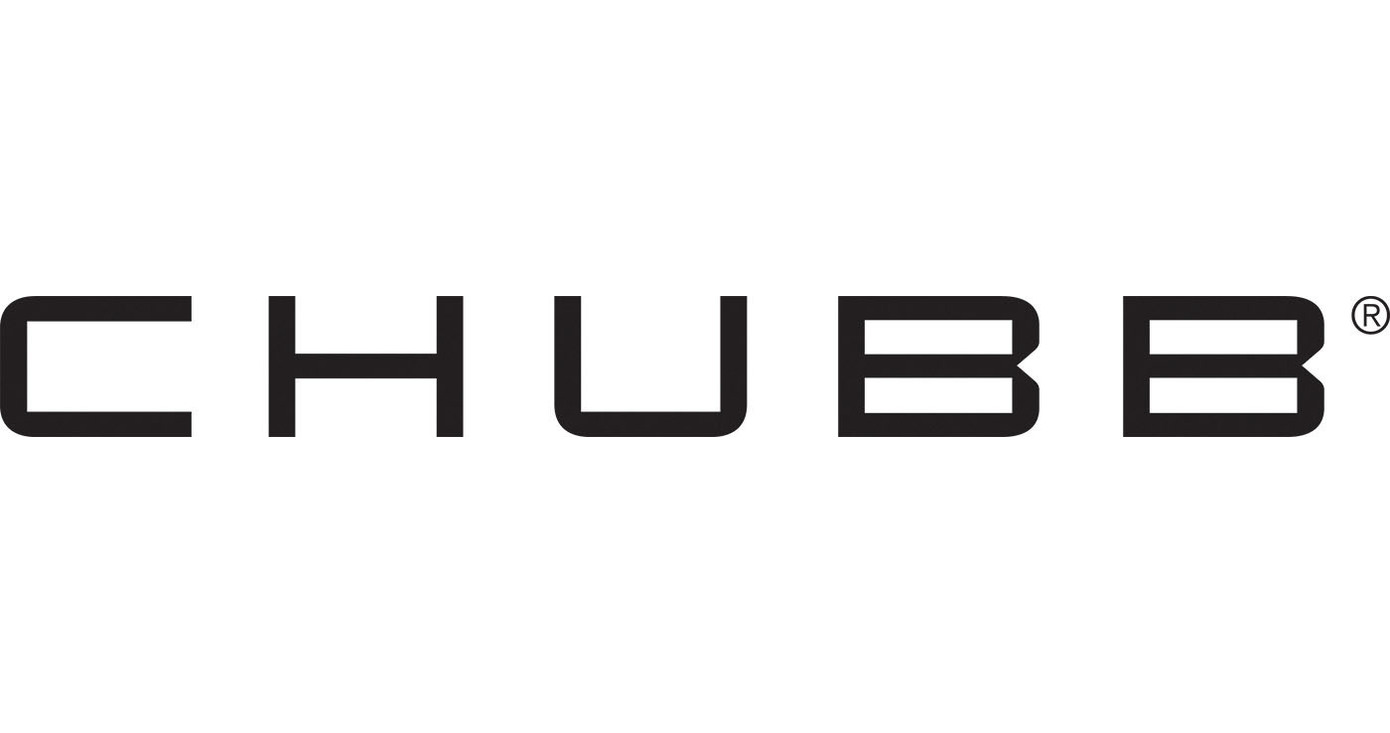
Chubb Reports Third Quarter Net Income Per Share of $6.99, Up 22.6%, and Record Core Operating Income Per Share of $7.49, Up 30.9%; Consolidated Net Premiums Written of $14.9 Billion, Up 7.5%; Record P&C Combined Ratio of 81.8%
ZURICH, Oct. 21, 2025 /PRNewswire/ — Chubb Limited (NYSE: CB) today reported net income for the quarter ended September 30, 2025 of $2.80 billion, or $6.99 per share, and core operating income of $3.00 billion, or $7.49 per share. Book value per share and tangible book value per share increased 4.7% and 6.6%, respectively, from June 30, 2025 and now stand at $182.22 and $120.13. Book value was favorably impacted by after-tax net realized and unrealized gains of $884 million in Chubb’s investment portfolio. Book value per share and tangible book value per share excluding AOCI increased 2.8% and 3.8%, from June 30, 2025.
|
Chubb Limited Third Quarter Summary (in millions of U.S. dollars, except per share amounts and ratios) (Unaudited) |
|||||||
|
(Per Share) |
|||||||
|
2025 |
2024 |
Change |
2025 |
2024 |
Change |
||
|
Net income |
$2,801 |
$2,324 |
20.5 % |
$6.99 |
$5.70 |
22.6 % |
|
|
Adjusted net realized (gains) losses and other, net of tax |
46 |
(220) |
NM |
0.11 |
(0.54) |
NM |
|
|
Market risk benefits (gains) losses, net of tax |
120 |
230 |
(47.8) % |
0.30 |
0.56 |
(46.4) % |
|
|
Amortization of deferred tax asset from Bermuda law |
36 |
– |
NM |
0.09 |
– |
NM |
|
|
Core operating income, net of tax |
$3,003 |
$2,334 |
28.7 % |
$7.49 |
$5.72 |
30.9 % |
|
|
Annualized return on equity (ROE) |
15.9 % |
14.7 % |
|||||
|
Core operating return on tangible equity (ROTE) |
24.5 % |
21.7 % |
|||||
|
Core operating ROE |
16.3 % |
13.9 % |
|||||
For the nine months ended September 30, 2025, net income was $7.10 billion, or $17.61 per share, and core operating income was $6.97 billion, or $17.29 per share. Book value per share and tangible book value per share increased 14.1% and 19.7%, from December 31, 2024. Book value was favorably impacted by after-tax net realized and unrealized gains of $3.25 billion in Chubb’s investment portfolio and $963 million of foreign currency gains. Book value per share and tangible book value per share excluding AOCI increased 7.3% and 10.1%, from December 31, 2024.
|
Chubb Limited Nine Months Ended Summary (in millions of U.S. dollars, except per share amounts and ratios) (Unaudited) |
|||||||
|
(Per Share) |
|||||||
|
2025 |
2024 |
Change |
2025 |
2024 |
Change |
||
|
Net income |
$7,100 |
$6,697 |
6.0 % |
$17.61 |
$16.38 |
7.5 % |
|
|
Adjusted net realized (gains) losses and other, net of tax |
(432) |
(189) |
128.6 % |
(1.07) |
(0.46) |
132.6 % |
|
|
Market risk benefits (gains) losses, net of tax |
213 |
238 |
(10.5) % |
0.53 |
0.58 |
(8.6) % |
|
|
Amortization of deferred tax asset (2025) and non- |
91 |
(55) |
NM |
0.22 |
(0.14) |
NM |
|
|
Core operating income, net of tax |
$6,972 |
$6,691 |
4.2 % |
$17.29 |
$16.36 |
5.7 % |
|
|
Annualized return on equity (ROE) |
13.9 % |
14.3 % |
|||||
|
Core operating return on tangible equity (ROTE) |
19.5 % |
21.3 % |
|||||
|
Core operating ROE |
13.0 % |
13.5 % |
|||||
For the nine months ended September 30, 2025 and 2024, the tax expenses (benefits) related to the table above were $50 million and $(76) million, respectively, for adjusted net realized gains and losses and other; $(38) million and nil for market risk benefits gains and losses; and $1.71 billion and $1.46 billion for core operating income.
Evan G. Greenberg, Chairman and Chief Executive Officer of Chubb Limited, commented: “We had a simply outstanding quarter. The results again put a point on the broad-based, diversified nature of our company geographically, by customer segment both and within commercial and consumer, by product and distribution channel. Core operating income of $3 billion was a record, up 29%, driven by record underwriting and investment income and double-digit growth in life income. Our core operating EPS was also a record, $7.49 per share, up 31%.
“Underwriting income on both a published and current accident year ex-catastrophe basis was supported by solid premium growth and underwriting margin improvement. Published underwriting income of $2.3 billion was up 55% from a year ago, with a record combined ratio of 81.8% — about six percentage points better than a year earlier. While we benefited from light CAT losses in the quarter, the real story is our underlying underwriting results, which were excellent, and very strong prior period reserve development. Current accident year underwriting income excluding CATs was a record $2.2 billion, up 10%, with a combined ratio of 82.5%, nearly a full-point improvement from prior year, with most all of it coming from loss ratio improvement.
“Adjusted net investment income of $1.8 billion was up 8.3%. Financial, economic and fiscal conditions favor continued attractive fixed income and alternative investment portfolio returns on our growing invested asset.
“Total company premiums grew 7.5%, with P&C up 5.3% and life up over 24.5%. All businesses and regions of the world contributed to growth. North America was up 4.4%, including growth of 8.1% in personal insurance and 3.5% in commercial, or 6.2% excluding the impact of two items that benefited the prior year. Overseas General was up 9.7%, including growth of 15.5% in consumer insurance and 5.8% in commercial insurance; Asia, Latin America and Europe were up 14.3%, 10.6% and 4.8%, respectively. Our balance of business and deep local presence provides us a wide range of opportunities around the world, which supports long-term, profitable growth, and it gives us additional freedom to manage a transitioning commercial P&C cycle with discipline.
“In the quarter, we increased share buybacks since our stock is trading well below intrinsic value. Given our earning power, increased buyback activity will continue, while at the same time we build additional capital and our invested asset base.
“In sum, Chubb’s fundamentals and our positioning are excellent, and our balance sheet, starting with our loss reserves, has never been stronger. I am confident we will maintain superior earnings growth, including double-digit growth in EPS, book and tangible book value, with core operating ROE increasing to 14% plus over the medium term, CATs and FX notwithstanding.”
Operating highlights for the quarter ended September 30, 2025 were as follows:
|
Chubb Limited |
Q3 |
Q3 |
|||
|
(in millions of U.S. dollars except for percentages) |
2025 |
2024 |
Change |
||
|
Consolidated |
|||||
|
Net premiums written (increase of 6.8% in constant dollars) |
$ |
14,866 |
$ |
13,829 |
7.5 % |
|
P&C |
|||||
|
Net premiums written (increase of 4.7% in constant dollars) |
$ |
12,934 |
$ |
12,277 |
5.3 % |
|
Underwriting income |
$ |
2,259 |
$ |
1,457 |
55.0 % |
|
Combined ratio |
81.8 % |
87.7 % |
|||
|
Current accident year underwriting income excluding catastrophe losses |
$ |
2,183 |
$ |
1,978 |
10.3 % |
|
Current accident year combined ratio excluding catastrophe losses |
82.5 % |
83.4 % |
|||
|
Global P&C (excludes Agriculture) |
|||||
|
Net premiums written (increase of 4.6% in constant dollars) |
$ |
11,476 |
$ |
10,898 |
5.3 % |
|
Underwriting income |
$ |
2,079 |
$ |
1,321 |
57.3 % |
|
Combined ratio |
81.0 % |
87.3 % |
|||
|
Current accident year underwriting income excluding catastrophe losses |
$ |
2,029 |
$ |
1,819 |
11.4 % |
|
Current accident year combined ratio excluding catastrophe losses |
81.6 % |
82.6 % |
|||
|
Life Insurance |
|||||
|
Net premiums written (increase of 23.5% in constant dollars) |
$ |
1,932 |
$ |
1,552 |
24.6 % |
|
Segment income (increase of 13.9% in constant dollars) |
$ |
324 |
$ |
284 |
14.2 % |
Details of financial results by business segment are available in the Chubb Limited Financial Supplement. Key segment items for the quarter ended September 30, 2025 are presented below:
|
Chubb Limited |
Q3 |
Q3 |
|||
|
(in millions of U.S. dollars except for percentages) |
2025 |
2024 |
Change |
||
|
Total North America P&C Insurance |
|||||
|
(Comprising NA Commercial P&C Insurance, NA Personal P&C Insurance and NA Agricultural Insurance) |
|||||
|
Net premiums written |
$ |
8,935 |
$ |
8,558 |
4.4 % |
|
Combined ratio |
79.2 % |
86.2 % |
|||
|
Current accident year combined ratio excluding catastrophe losses |
80.6 % |
81.8 % |
|||
|
North America Commercial P&C Insurance |
|||||
|
Net premiums written (1) |
$ |
5,663 |
$ |
5,500 |
2.9 % |
|
Major accounts retail and excess and surplus (E&S) wholesale |
$ |
3,379 |
$ |
3,296 |
2.5 % |
|
Middle market and small commercial |
$ |
2,284 |
$ |
2,204 |
3.6 % |
|
Combined ratio |
81.5 % |
86.5 % |
|||
|
Current accident year combined ratio excluding catastrophe losses |
80.8 % |
80.8 % |
|||
|
North America Personal P&C Insurance |
|||||
|
Net premiums written |
$ |
1,814 |
$ |
1,679 |
8.1 % |
|
Combined ratio |
65.1 % |
81.3 % |
|||
|
Current accident year combined ratio excluding catastrophe losses |
72.1 % |
78.7 % |
|||
|
North America Agricultural Insurance |
|||||
|
Net premiums written |
$ |
1,458 |
$ |
1,379 |
5.6 % |
|
Combined ratio |
88.0 % |
90.4 % |
|||
|
Current accident year combined ratio excluding catastrophe losses |
89.7 % |
88.9 % |
|||
|
Overseas General Insurance |
|||||
|
Net premiums written (increase of 7.4% in constant dollars) |
$ |
3,695 |
$ |
3,367 |
9.7 % |
|
Commercial P&C |
$ |
2,114 |
$ |
1,999 |
5.8 % |
|
Consumer P&C |
$ |
1,581 |
$ |
1,368 |
15.5 % |
|
Combined ratio |
83.3 % |
86.0 % |
|||
|
Current accident year combined ratio excluding catastrophe losses |
84.4 % |
84.8 % |
|||
|
Global Reinsurance |
|||||
|
Net premiums written |
$ |
304 |
$ |
352 |
(13.5) % |
|
Combined ratio |
77.4 % |
94.4 % |
|||
|
Current accident year combined ratio excluding catastrophe losses |
75.6 % |
75.8 % |
|||
|
Life Insurance |
|||||
|
Net premiums written |
$ |
1,932 |
$ |
1,552 |
24.6 % |
|
Segment income |
$ |
324 |
$ |
284 |
14.2 % |
|
(1) See page 6 for additional details |
|||||
All comparisons are with the same period last year unless otherwise specifically stated.
Please refer to the Chubb Limited Financial Supplement, dated September 30, 2025, which is posted on Chubb’s investor relations website, investors.chubb.com, in the Financials section for more detailed information on individual segment performance, together with additional disclosure on reinsurance recoverable, loss reserves, investment portfolio, and debt and capital.
Chubb Limited will hold its third quarter earnings conference call on Wednesday, October 22, 2025, at 8:30 a.m. Eastern. The earnings conference call will be available via live webcast at investors.chubb.com or by dialing 877-400-4403 (within the United States) or 332-251-2601 (international), passcode 1641662. Please refer to the Chubb website under Events and Presentations for details. A replay will be available after the call at the same location. To listen to the replay, please click here to register and receive dial-in numbers.
In this release, business activity for, and the financial position of, Chubb acquisitions are reported at 100%, as required, except for core operating income, net income, book value, tangible book value, ROE, per share data, and certain other key metrics, which include only Chubb’s ownership interest and exclude the non-controlling interest.
Prior period core operating income and related metrics have been redefined to reflect the definition of core operating income adopted in Q1 2025, which excludes the non-recurring tax benefit related to the enactment of Bermuda’s income tax law in 2023. Refer to “Regulation G – Non-GAAP Financial Measures” below for more information.
About Chubb
Chubb is a world leader in insurance. With operations in 54 countries and territories, Chubb provides commercial and personal property and casualty insurance, personal accident and supplemental health insurance, reinsurance and life insurance to a diverse group of clients. The company is defined by its extensive product and service offerings, broad distribution capabilities, exceptional financial strength and local operations globally. Parent company Chubb Limited is listed on the New York Stock Exchange (NYSE: CB) and is a component of the S&P 500 index. Chubb employs approximately 43,000 people worldwide. Additional information can be found at: www.chubb.com.
Regulation G – Non-GAAP Financial Measures
In presenting our results, we included and discussed certain non-GAAP measures. These non-GAAP measures, which may be defined differently by other companies, are important for an understanding of our overall results of operations and financial condition. However, they should not be viewed as a substitute for measures determined in accordance with generally accepted accounting principles (GAAP).
Throughout this document there are various measures presented on a constant-dollar basis (i.e., excludes the impact of foreign exchange). We believe it is useful to evaluate the trends in our results exclusive of the effect of fluctuations in exchange rates between the U.S. dollar and the currencies in which our international business is transacted, as these exchange rates could fluctuate significantly between periods and distort the analysis of trends. The impact is determined by assuming constant foreign exchange rates between periods by translating prior period results using the same local currency exchange rates as the comparable current period.
Adjusted net investment income is net investment income excluding the amortization of the fair value adjustment on acquired invested assets from certain acquisitions of $1 million and $5 million in Q3 2025 and Q3 2024, and including investment income of $127 million in both Q3 2025 and Q3 2024, from partially owned investment companies (private equity partnerships) where our ownership interest is in excess of 3% that are accounted for under the equity method. The amortization of the fair value adjustment on acquired invested assets was $7 million and $14 million for the nine months ended September 30, 2025 and 2024, and the investment income from private equity partnerships was $349 million and $304 million for the nine months ended September 30, 2025 and 2024. The mark-to-market movement on these private equity partnerships are included in adjusted net realized gains (losses) as described below. We believe this measure is meaningful as it highlights the underlying performance of our invested assets and portfolio management in support of our lines of business.
Adjusted net realized gains (losses) and other, net of tax, includes net realized gains (losses) and net realized gains (losses) recorded in other income (expense) related to unconsolidated subsidiaries, and excludes realized gains and losses on crop derivatives and realized gains and losses on underlying investments supporting the liabilities of certain participating policies related to the policyholders’ share of gains and losses. The crop derivatives were purchased to provide economic benefit, in a manner similar to reinsurance protection, in the event that a significant decline in commodity pricing impacts underwriting results. We view gains and losses on these derivatives as part of the results of our underwriting operations, and therefore realized gains (losses) from these derivatives are reclassified to adjusted losses and loss expenses. The realized gains and losses on underlying investments supporting the liabilities of certain participating policies have been reclassified from net realized gains (losses) to adjusted policy benefits. We believe this better reflects the economics of the liabilities and the underlying investments supporting those liabilities. Other includes integration expenses and the amortization of fair value adjustment of acquired invested assets and long-term debt related to certain acquisitions. See Core operating income, net of tax for further description of these items.
P&C underwriting income (loss) excludes the Life Insurance segment and is calculated by subtracting adjusted losses and loss expenses, adjusted policy benefits, policy acquisition costs and administrative expenses from net premiums earned. We use underwriting income (loss) and operating ratios to monitor the results of our operations without the impact of certain factors, including net investment income, other income (expense), interest expense, amortization expense of purchased intangibles, integration expenses, amortization of fair value of acquired invested assets and debt, income tax expense, adjusted net realized gains (losses), and market risk benefits gains (losses).
P&C current accident year underwriting income excluding catastrophe losses is P&C underwriting income adjusted to exclude P&C catastrophe losses and prior period development (PPD). We believe it is useful to exclude catastrophe losses, as they are not predictable as to timing and amount, and PPD as these unexpected loss developments on historical reserves are not indicative of our current underwriting performance. We believe the use of these measures enhances the understanding of our results of operations by highlighting the underlying profitability of our insurance business. References in this release to “current accident year” metrics exclude catastrophe losses and prior period development, unless stated otherwise.
Core operating income relates only to Chubb income, which excludes noncontrolling interests. It excludes from Chubb net income the after-tax impact of adjusted net realized gains (losses) and other, which include items described in this paragraph, and market risk benefits gains (losses). We believe this presentation enhances the understanding of our results of operations by highlighting the underlying profitability of our insurance business. We exclude adjusted net realized gains (losses) and market risk benefits gains (losses) because the amount of these gains (losses) is heavily influenced by, and fluctuates in part according to, the availability of market opportunities. In addition, we exclude the amortization of fair value adjustments on purchased invested assets and long-term debt related to certain acquisitions due to the size and complexity of these acquisitions. We also exclude integration expenses, which include legal and professional fees and all other costs directly related to acquisition integration activities. The costs are not related to the ongoing activities of the individual segments and are therefore included in Corporate and excluded from our definition of segment income. We believe these integration expenses are not indicative of our underlying profitability, and excluding these integration expenses facilitates the comparison of our financial results to our historical operating results. Additionally, we exclude the non-recurring tax benefit from the Bermuda Economic Transition Adjustment enacted in 2023 and adjusted in 2024 and subsequent years’ amortization of the related deferred tax asset, which we believe provides investors with a better view of our operating performance, enhances the understanding of the trends in the underlying business, improves comparability between periods and provides increased transparency compared to the prior presentation of the non-recurring tax benefit. References to core operating income measures mean net of tax, whether or not noted.
Core operating return on equity (ROE) and Core operating return on tangible equity (ROTE) are annualized non-GAAP financial measures. The numerator includes core operating income (loss), net of tax. The denominator includes the average Chubb shareholders’ equity for the period adjusted to exclude unrealized gains (losses) on investments, current discount rate on future policy benefits (FPB), and instrument-specific credit risk on market risk benefits (MRB), all net of tax and attributable to Chubb. For the ROTE calculation, the denominator is also adjusted to exclude Chubb goodwill and other intangible assets, net of tax. These measures enhance the understanding of the return on shareholders’ equity by highlighting the underlying profitability relative to shareholders’ equity and tangible equity excluding the effect of these items as these are heavily influenced by changes in market conditions. We believe ROTE is meaningful because it measures the performance of our operations without the impact of goodwill and other intangible assets.
P&C combined ratio is the sum of the loss and loss expense ratio, acquisition cost ratio and the administrative expense ratio excluding the life business and including the realized gains and losses on the crop derivatives, as noted above.
P&C current accident year combined ratio excluding catastrophe losses excludes the impact of P&C catastrophe losses and PPD from the P&C combined ratio. We believe this measure provides a useful evaluation of our underwriting performance and enhances the understanding of the trends in our P&C business that may be obscured by these items.
Global P&C performance metrics comprise consolidated operating results (including corporate) and exclude the operating results of Chubb’s Life Insurance and North America Agricultural Insurance segments. The agriculture insurance business is a different business in that it is a public sector and private sector partnership in which insurance rates, premium growth, and risk-sharing is not market-driven like the remainder of Chubb’s P&C insurance business. We believe that these measures are useful and meaningful to investors as they are used by management to assess Chubb’s global P&C operations which are the most economically similar. We exclude the North America Agricultural Insurance and Life Insurance segments because the results of these businesses do not always correlate with the results of our global P&C operations.
Tangible book value per common share is Chubb shareholders’ equity less Chubb goodwill and other intangible assets, net of tax, divided by the shares outstanding. We believe that goodwill and other intangible assets are not indicative of our underlying insurance results or trends and make book value comparisons to less acquisitive peer companies less meaningful.
Book value per share and tangible book value per share excluding accumulated other comprehensive income (loss) (AOCI), excludes AOCI from the numerator because it eliminates the effect of items that can fluctuate significantly from period to period, primarily based on changes in interest rates and foreign currency movement, to highlight underlying growth in book and tangible book value.
Adjusted operating cash flow is Operating cash flow excluding the operating cash flow related to the net investing activities of Huatai’s asset management companies as it relates to the Consolidated Investment Products as required under consolidation accounting. Because these entities are investment companies, we are required to retain the investment company presentation in our consolidated results, which means, we include the net investing activities of these entities in our operating cash flows. Chubb has elected to remove the impact of net investing activities of consolidated investment companies from our operating cash flow as they may distort a reader’s analysis of our underlying operating cash flow related to the core insurance company operations. These net investing activities are more appropriately classified outside of operating cash flows, consistent with our consolidated investing activities. Accordingly, we believe that it is appropriate to adjust operating cash flow for the impact of consolidated investment products.
Life Insurance and International life insurance net premiums written and deposits collected includes deposits collected on universal life and investment contracts (life deposits). Life deposits are not reflected as revenues in our consolidated statements of operations in accordance with U.S. GAAP. However, we include life deposits in presenting growth in our life insurance business because life deposits are an important component of production and key to our efforts to grow our business.
See the reconciliation of Non-GAAP Financial Measures on pages 27-33 in the Financial Supplement. These measures should not be viewed as a substitute for measures determined in accordance with GAAP, including premium, net income, book value, return on equity, and net investment income.
NM – not meaningful comparison
Cautionary Statement Regarding Forward-Looking Statements:
Forward-looking statements made in this press release, such as those related to company performance, pricing, growth opportunities, economic and market conditions, and our expectations and intentions and other statements that are not historical facts, reflect our current views with respect to future events and financial performance and are made pursuant to the safe harbor provisions of the Private Securities Litigation Reform Act of 1995. Such statements involve risks and uncertainties that could cause actual results to differ materially, including without limitation, the following: competition, pricing and policy term trends, the levels of new and renewal business achieved, the frequency and severity of unpredictable catastrophic events, actual loss experience, uncertainties in the reserving or settlement process, integration activities and performance of acquired companies, loss of key employees or disruptions to our operations, new theories of liability, judicial, legislative, regulatory and other governmental developments, litigation tactics and developments, investigation developments and actual settlement terms, the amount and timing of reinsurance recoverable, credit developments among reinsurers, rating agency action, possible terrorism or the outbreak and effects of war, economic, political, regulatory, insurance and reinsurance business conditions, potential strategic opportunities including acquisitions and our ability to achieve them, as well as management’s response to these factors, and other factors identified in our filings with the Securities and Exchange Commission (SEC). Readers are cautioned not to place undue reliance on these forward-looking statements, which speak only as of the dates on which they are made. We undertake no obligation to publicly update or revise any forward-looking statements, whether as a result of new information, future events or otherwise.
|
Chubb Limited |
||||||
|
Summary Consolidated Balance Sheets |
||||||
|
(in millions of U.S. dollars, except per share data) |
||||||
|
(Unaudited) |
||||||
|
September 30 2025 |
December 31 |
|||||
|
Assets |
||||||
|
Investments |
$ |
165,996 |
$ |
150,650 |
||
|
Cash and restricted cash |
2,454 |
2,549 |
||||
|
Insurance and reinsurance balances receivable |
16,305 |
14,426 |
||||
|
Reinsurance recoverable on losses and loss expenses |
20,227 |
19,777 |
||||
|
Goodwill and other intangible assets ($25,883 and $25,219 represents |
26,555 |
25,956 |
||||
|
Other assets |
38,673 |
33,190 |
||||
|
Total assets |
$ |
270,210 |
$ |
246,548 |
||
|
Liabilities |
||||||
|
Unpaid losses and loss expenses |
$ |
88,439 |
$ |
84,004 |
||
|
Unearned premiums |
26,961 |
23,504 |
||||
|
Other liabilities |
76,999 |
70,646 |
||||
|
Total liabilities |
192,399 |
178,154 |
||||
|
Shareholders’ equity |
||||||
|
Chubb shareholders’ equity, excl. AOCI |
76,747 |
72,665 |
||||
|
Accumulated other comprehensive income (loss) (AOCI) |
(4,892) |
(8,644) |
||||
|
Chubb shareholders’ equity |
71,855 |
64,021 |
||||
|
Noncontrolling interests |
5,956 |
4,373 |
||||
|
Total shareholders’ equity |
77,811 |
68,394 |
||||
|
Total liabilities and shareholders’ equity |
$ |
270,210 |
$ |
246,548 |
||
|
Book value per common share |
$ |
182.22 |
$ |
159.77 |
||
|
Tangible book value per common share |
$ |
120.13 |
$ |
100.38 |
||
|
Book value per common share, excl. AOCI |
$ |
194.63 |
$ |
181.34 |
||
|
Tangible book value per common share, excl. AOCI |
$ |
130.60 |
$ |
118.57 |
||
|
Chubb Limited |
|||||||||||||
|
Summary Consolidated Financial Data |
|||||||||||||
|
(in millions of U.S. dollars, except share, per share data, and ratios) |
|||||||||||||
|
(Unaudited) |
|||||||||||||
|
Three Months Ended |
Nine Months Ended |
||||||||||||
|
September 30 |
September 30 |
||||||||||||
|
2025 |
2024 |
2025 |
2024 |
||||||||||
|
Gross premiums written |
$ |
18,069 |
$ |
16,761 |
$ |
50,450 |
$ |
47,677 |
|||||
|
Net premiums written |
14,866 |
13,829 |
41,708 |
39,410 |
|||||||||
|
Net premiums earned |
14,359 |
13,373 |
39,484 |
37,248 |
|||||||||
|
Losses and loss expenses |
6,951 |
7,383 |
20,419 |
19,541 |
|||||||||
|
Policy benefits |
1,372 |
1,099 |
4,005 |
3,498 |
|||||||||
|
Policy acquisition costs |
2,563 |
2,324 |
7,291 |
6,757 |
|||||||||
|
Administrative expenses |
1,138 |
1,094 |
3,343 |
3,258 |
|||||||||
|
Net investment income |
1,648 |
1,508 |
4,777 |
4,367 |
|||||||||
|
Net realized gains (losses) |
283 |
198 |
327 |
201 |
|||||||||
|
Market risk benefits gains (losses) |
(142) |
(230) |
(251) |
(238) |
|||||||||
|
Interest expense |
197 |
192 |
559 |
552 |
|||||||||
|
Other income (expense): |
|||||||||||||
|
Gains (losses) from separate account assets |
(9) |
(30) |
(31) |
(9) |
|||||||||
|
Other |
52 |
355 |
812 |
635 |
|||||||||
|
Amortization of purchased intangibles |
75 |
81 |
224 |
241 |
|||||||||
|
Integration expenses |
1 |
7 |
3 |
21 |
|||||||||
|
Income tax expense |
787 |
504 |
1,825 |
1,336 |
|||||||||
|
Net income |
$ |
3,107 |
$ |
2,490 |
$ |
7,449 |
$ |
7,000 |
|||||
|
Less: NCI income |
306 |
166 |
349 |
303 |
|||||||||
|
Chubb net income |
$ |
2,801 |
$ |
2,324 |
$ |
7,100 |
$ |
6,697 |
|||||
|
Diluted earnings per share: |
|||||||||||||
|
Chubb net income |
$ |
6.99 |
$ |
5.70 |
$ |
17.61 |
$ |
16.38 |
|||||
|
Core operating income |
$ |
7.49 |
$ |
5.72 |
$ |
17.29 |
$ |
16.36 |
|||||
|
Weighted average shares outstanding |
400.9 |
407.9 |
403.2 |
408.9 |
|||||||||
|
P&C combined ratio |
|||||||||||||
|
Loss and loss expense ratio |
56.7 % |
63.1 % |
60.8 % |
60.8 % |
|||||||||
|
Policy acquisition cost ratio |
17.7 % |
17.2 % |
18.5 % |
18.0 % |
|||||||||
|
Administrative expense ratio |
7.4 % |
7.4 % |
8.0 % |
8.1 % |
|||||||||
|
P&C combined ratio |
81.8 % |
87.7 % |
87.3 % |
86.9 % |
|||||||||
|
P&C underwriting income |
$ |
2,259 |
$ |
1,457 |
$ |
4,331 |
$ |
4,275 |
|||||
SOURCE Chubb Limited
For further information: Investor Contact: Karen Beyer: (212) 827-4445; karen.beyer@chubb.com; Media Contact: mediarelations@chubb.com
This request seems a bit unusual, so we need to confirm that you’re human. Please press and hold the button until it turns completely green. Thank you for your cooperation!
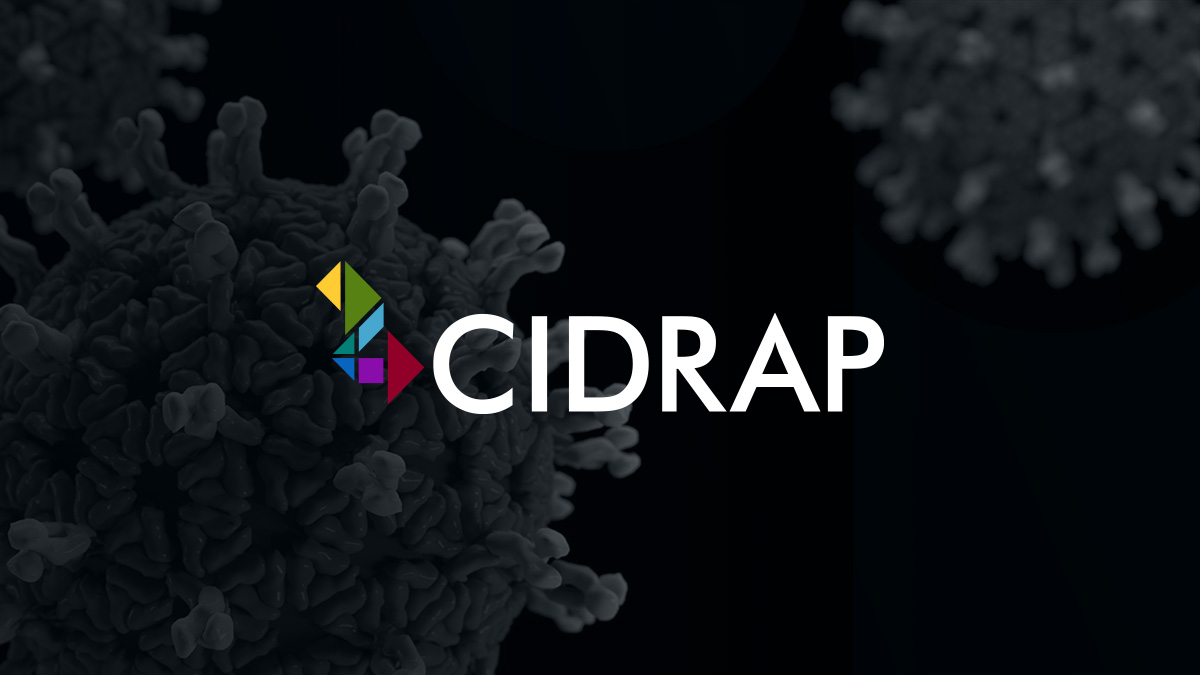
Today the European Centre for Disease Prevention and Control (ECDC) said European nations must work to increase their seasonal influenza vaccine uptake as the respiratory infection season approaches, especially among…
This request seems a bit unusual, so we need to confirm that you’re human. Please press and hold the button until it turns completely green. Thank you for your cooperation!